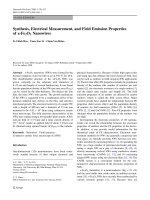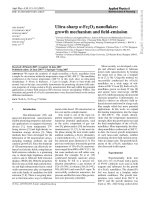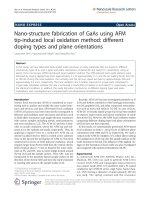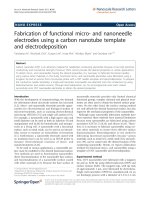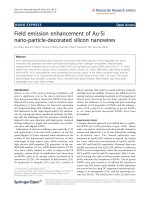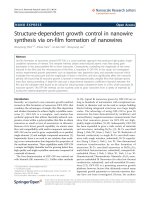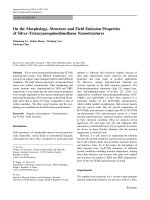Interconnection of electrodes using field emission induced growth of nanowires
Bạn đang xem bản rút gọn của tài liệu. Xem và tải ngay bản đầy đủ của tài liệu tại đây (3.87 MB, 102 trang )
Interconnection Of Electrodes Using Field Emission Induced Growth Of
Nanowires
FAIZHAL BIN BAKAR
B. ENG. (Hons), NUS
A THESIS SUBMITTED
FOR THE DEGREE OF MASTER OF ENGINEERING
NATIONAL UNIVERSITY OF SINGAPORE NANOSCIENCE AND
NANOTECHNOLOGY INTIATIVE
2009
a
Acknowledgement
I would like to thank my Supervisor, Assoc. Prof. Dr. John Thong for his ideas
and patience in the completion of this work.
I would also like to thank the staff of the Center for Integrated Circuit Failure
Analysis and Reliability (CICFAR), Mrs. CM Ho and Mr. CK Koo, for their logistical
support in the execution of these experiments. I would also like to thank Dr. CH Oon for
sharing his expertise in the experimental section of this work.
i
Contents
Page
Acknowledgements
i
Contents
ii
Abstract
v
List of figures
vi
Chapter 1. Introduction
1.1 Nanowire fabrication
2
1.2 Integration of Nanowires
3
1.3 Objective and thesis outline
7
Chapter 2. Literature Review
2.1 Dielectrophoresis
9
2.1.1 Bridging using nanoparticles
10
2.1.2 Bridging using CNTs and nanowire
13
2.2 Electroplating
15
2.3 Chalcogenide Based Electrical Switching
17
2.4 Field Emission Induced Growth
19
Chapter 3. Cathode Growth Simulation
3.1 Simulation
25
3.1.2 Simulation parameters
26
3.2 Simulation results
33
3.2.1 Simulation of emitted rays
33
ii
3.2.2 Simulation of W ions
3.3 Summary
36
45
Chapter 4. Fabrication of Lateral Field Emission Structures
4.1 Cathode Requirements
47
4.2 Fabrication Of Planar Si Electrodes
50
4.2.1 Si Die Fabrication
50
4.2.2 Si tips through FIB milling
53
4.2.3 Directly-grown ZnO tips
55
4.2.4 CNT Tips Through Dielectrophoresis
57
4.3 Summary
58
Chapter 5. Experimental Study of FEIG Growth
5.1 Bridging Of Cathode Nanowire Growth
59
5.1.1 Experimental Setup
59
5.1.2 Experimental Results
61
5.2 Anode Growth
68
5.3 Simulation Of Anode Growth
72
5.3.1 Simulation set up
73
5.3.2 Simulation results
74
5.4 TEM Imaging Of Anode Growth
77
5.5 Summary
80
iii
Chapter 6. Conclusion
6.1 Summary
82
6.2 Future Work
83
References
85
iv
Abstract
This thesis concerns the interconnection of electrodes using field emission induced
growth (FEIG) of W nanowires. We seek to understand the process through simulation of
the growth phenomena seen at both the cathode and the anode. Better experimentation
and understanding of FEIG will bring a step closer to understanding of the formation of
nanosized connection between electrodes. Results of the simulation of electron and W
ions trajectories at the beginning stage of the nanowire growth suggests a formation of a
conical supporting structure at the base of the nanowire as well the formation of a
nanowire with a diameter that grows at a much smaller rate than its length. Results of
simulation at the end stage of the nanowire growth suggest that nanowire growth speed
reduces as the nanowire nears the anode. The measured resistance of W nanowire bridge
however shows a large ohmic value due to the high resistance of the anode growth due W
supply-limited deposition. The anode growth observed is thicker and has a tree-like
structure and is deduced to arise from the continual fusing and growth of the cathode
which encourages the anode growth as the thicker anode is unlikely to fuse. Preliminary
anode simulations suggest that formation of protrusions at the anode will influence
incoming electrons and thus the fractal growth of the anode observed. From TEM
images, it was deduced that the tree-like anode growth is made up of metal agglomerates,
enclosed in a carbonaceous matrix. The low crystallinity observed is deduced to be due to
the low electron energy used.
v
List of
Figures
Caption
Page
Figure 1.1
Schematic illustrations of six different methods of achieving 3
1D growth: (A) dictation by the anisotropic crystallographic
structure of a solid; (B) confinement by a liquid droplet as in
the vapor-liquid-solid process; (C) direction through the use
of a template; (D) kinetic control provide by a capping
reagent; (E) self-assembly of 0-Dimensional nanostructures;
and (F) size reduction of a 1D microstructure. Source: Xia et
al. (2003)
Figure 1.2
(a) Schematic illustration of the fabrication of the VLS
grown Si nanowire bridge between two vertical Si{111}
surfaces. (b) SEM image of nanowire bridges grown in the
microtrenches. He R. et al (2005)
Figure 1.3
(a) SEM top view of a hexagonal network of SWNTs (line- 5
like structures) suspended on top of silicon posts (bright
dots). (b) SEM top view of a square network of suspended
SWNTs. (c) Side view of a suspended SWNT power line on
silicon posts (bright). (d) SWNTs suspended by silicon
structures (bright regions). The nanotubes are aligned along
the electric field direction. Source: Dai et al (2002)
Figure 1.4
A nanowire was grown via FEIG and was allowed to 6
straddle across two metal electrodes. Source: Oon et al
(2004)
Figure 1.5
Electrons from field-emitting tip (illustrated by the dashed
lines) dissociates the precursor W(CO)6 into W+ ions which
accelerates towards the field emitting tip to form the
nanowire. Neutral carbon atoms intercepted by the wire
forms the amorphous overcoat. Source: Oon et al. (2006)
7
Figure 2.1
(a) Pt electrodes separated by a ~14 nm gap (b) After
electrostatic trapping of a ~17 nm Pd nanoparticle. Source:
Bezryadin and Dekker (1997)
10
Figure 2.2
(a) 400 nm electrode gap bridged by fused 50 nm Au
nanoparticles. (b) sub-10 nm gap after electromigration
failure due to DC biasing. Source: Khondaker and Yao
(2002)
11
Figure 2.3
500 nm electrode gap bridged by 120 ± 20 nm Au 11
5
vi
nanoparticles at an applied voltage of (a) 2 V and (b) 1 V.
Source: Bernard et al. (2007)
Figure 2.4
(a) Schematic of 3D platform (b) Process flow of 3D 12
platform (b)(i) Thermally grown oxide and Au deposition
patterned using lift-off. (b)(ii) Deposition of Parylene and
Au patterned using lift-off. (b)(iii) Etching of Parylene layer
(b)(iv)
Assembly
of
Au
nanoparticles
using
dielectrophoresis. Source: Nishant et al. (2007)
Figure 2.5
SEM micrograph of assembled Au nanoparticles on 3D 12
platform using dielectrophoresis. Source: Nishant et al.
(2007)
Figure 2.6
A higher AC frequency improves the degree of orientation 13
and reduces the amount of the CNT to carbon particulate
ratio. Source: Yamamoto et al. (1998)
Figure 2.7
A higher AC peak-to-peak voltage gives a larger amount of
aligned CNTs. Source: Chen et al. (2001)
Figure 2.8
A single CNT bundle trapped through dielectrophoresis. 15
Source: Krupke et al. (2003)
Figure 2.9
3-electrode configuration with the ‘source’ (left), ‘latch’ 15
(middle) and ‘drain’ (right). (a), (b) and (e) assembly of
nanowires using ‘source’ and ‘latch’ relative phase of 180º.
(c) and (d) assembly of nanowires using ‘source’ and ‘latch’
relative phase of 0º. Source: Wissener-Gross et al. (2006)
Figure 2.10
The experimental set-up, Vdc controls deposition or removal 16
of material while Vac is used to monitor the conductance and
thus the conductance. Source: Morpurgo et al. (1999)
Figure 2.11
(A) Schematic and SEM images of electrodes before
deposition. (B) Schematic and SEM images of electrodes
after deposition. Source: Morpurgo et al (1999)
Figure 2.12
(a) Schematic illustration lateral device with Au-Ag 18
electrodes on As2S3 Film. (b) Ag dendrite grows from the
Au electrode towards the Ag electrode. (c) Ag dendrite
bridged the electrodes. Source: Yooichi et al. (2005)
Figure 2.13
Schematic of (a) synthesis of Ag/Ag2S heteronanowire 18
arrays and (b) electrochemical sulfurization growth of Ag2S.
Source: Liang et al. (2005)
14
16
vii
Figure 2.14
Schematic of the switching on and off by breaking the 19
nanobridge connections through application of reversible
voltages. Source: Liang et al. (2005)
Figure 2.15
Glow discharge growths on the cathode having the structure 20
of a thin core with unoriented microcrystals grown on the
core. Source: Okuyama (1980)
Figure 2.16
A grown nanowire of 1-2µm in length is attracted to an 22
adjacently biased electrode without fusing. Source: Thong et
al. (2002)
Figure 3.1
Dissociation of W(CO)6 occurs due to electron 26
bombardment originating from the field emission tip.
Positively charged W+ ions accelerate towards the cathode
tip and form the nanowire. Dissociated C accounts for the
carbonaceous coating.
Figure 3.2
(a) 2D drawn structure with an axial symmetry. (b)
Equivalent 3D structure
27
Figure 3.3
2D drawn schematic with the simulated electric field
27
Figure 3.4
Illustrating the method of approximating the area occupied
by rays of electrons
28
Figure 3.5
Discretizing emitted rays into 20nm sections
31
Figure 3.6
Ray data from ‘crosses’ are collected by test planes and ray
data from ‘dots’ will be spline interpolated. The ray data
collected are its current magnitude, its location, and its
electron energy.
32
Figure 3.7
Ionization cross-section curves of CH4, Si(CH3)4 and SF6
having a similar hill like shape but with differing energies
for the onset of ionization and ionization turning point.
Sources: CH4 - Y.-K. Kim et al. (1997), Si(CH3)4 - M. A.
Ali et al. (1997), SF6 - M. A. Ali et al. (2000)
33
Figure 3.8
Current density reduces with perpendicular distance from
the cathode due to diverging rays. The highest and lowest
current density recorded differs by 10 orders of magnitude
35
viii
Figure 3.9
Areas with filled dots are locations where W ions will be
located and launched from. Areas that are not traversed by
electron rays will not have W ions and are indicated with
open dots
37
Figure 3.10
Trajectory of launched W ions moving towards the Cathode
38
Figure 3.11
The cathode is discretized into 20nm sized sections where
landed W ions are taken count. A magnified view of the
pointed end of the cathode showing where the Tip of the
cathode is defined as another discrete section.
39
Figure 3.12
Simulation done for W ions distribution. Voltage applied is
245V with an applied current of ~120nA. (a) W ions
distribution along the base of the nanowire (A). (b) W ions
distribution along the nanowire (B). (c) Schematic of the
simulation set up.
41
Figure 3.13
Simulation done for W ions distribution. Voltage applied is
93V with an applied current of ~120nA. (a) W ions
distribution along the base of the nanowire (A). (b) W ions
distribution along the nanowire (B). (c) Schematic of the
simulation set up.
44
Figure 3.14
From work done by Yeong et al (2006), the growth rate of
W nanowire decreases with time
45
Figure 4.1
A simple 3D schematic of a field emission structure to be
fabricated
47
Figure 4.2
The field enhancement factor, β, is expressed as β = (h/r) h
is the height of the protrusion and r is the radius of the tip of
the protrusion.
49
Figure 4.3
Cross-sectional schematic of the Si die showing the 51
anisotropic profile due to wet etching using KOH:IPA:DIW
(200g : 63.5 cm3 : 250 cm3) at 85 °C. A 1500 Å patterned
nitride was used in the wet etch as a bottom-side mask.
Figure 4.4
Electrode patterns for (a) 3x3 mm2 die and (b) 5x5 mm2
chip
51
Figure 4.5
E-Beam Lithography pattern with the smallest line width at
5μm
52
ix
Figure 4.6
Optical micrograph after 2 levels of optical and E-Beam
lithography with deposition of Au and Al as electrodes and
hard mask respectively
52
Figure 4.7
(a) & (b) Etched Si before patterning with FIB. The yellow
areas indicate locations to be sputtered away by FIB. (c) &
(d) After patterning with FIB.
53
Figure 4.8
Due to the conical shaped ion beam, milling of a donut
shaped mask will not result in a flat tipped cylindrical
protrusion but rather a sharp tipped conical protrusion.
54
Figure 4.9
Examples of structures milled using a donut fill FIB mask
with an ion bean in the direction shown by the thick arrows.
55
Figure 4.10
ZnO nanowire grown from a lithographically patterned zinc
island on the top of Si electrodes
56
Figure 4.11
Field emission caused patches of ZnO to be detached from
the electrodes
56
Figure 4.12
CNTs placed onto Si electrodes via dielectrophoresis
57
Figure 5.1
Sketch of a fabricated sample placed on a holder that is
built with an inlet for supply of W(CO)6 precursor gas.
60
Figure 5.2
Overall Experimental setup
60
Figure 5.3
Growth voltage at constant current fluctuates suggesting
capacitive discharge when bridged nanowire touches
opposite anode. Stable voltage at the end of the growth
suggests that lasting bridge between cathode and anode has
formed.
61
Figure 5.4
Expected Voltage to Time relationship during constant
current growth of the nanowire. ‘G’ = nanowire growth,
‘F’ = fusing event, ‘B’ = bridge formation (steady state).
63
x
Figure 5.5
(a) The fabricated field emission set up with 4 electrodes. 2
electrodes are kept floating while another 2 electrodes are
chosen as the anode and cathode. A grown nanowire can be
seen between the cathode and anode. W deposited via EBID
onto the surface of the substrate (dotted circle) is also
shown. (b) A magnified view of the bridging nanowire with
two structural parts. A thick and tree-like portion (A) closer
to the anode and a thinner portion closer to the cathode (B).
64
Figure 5.6
The process of cathode FEIG nanowire fusing and growth
that leads to a longer anode growth compared to the
cathode.
65
Figure 5.7
I-V curve of the bridged nanowire shows that bridge is
ohmic with a resistance of 130 MΩ.
67
Figure 5.8
(a) Shows a nanowire grown with a slight mound on the
anode formed after 2 seconds of initial growth. (b) Growth
+5 secs shows a longer nanowire has grown longer and an
increase in size of the mound at the anode. A sharp
protrusion has formed at the tip of the mound. (c) Growth
+2 secs shows a connection has occurred. Growth from the
anode is generally thicker and branchlike.
69
Figure 5.9
Shaded area shows the range of onset for surface
dissociation of W(CO)6 (a) Constant current growth voltage
of from this work. (b) Constant current growth voltage from
Yeong et al.(2006). Inset: cathode and anode growths at 78s
growth time.
71
Figure 5.10
(a) shows that a mound forms simply due to higher electron
current density around the center. (b) Formation of sharper
protrusion causes incoming electrons to be focused.
73
Figure 5.11
A 3D drawn schematic in CPO. The highlighted dotted area
signifies the quadrant where the landing coordinates of the
electron trajectories are taken before and after the
protrusions are placed.
75
Figure 5.12
Simulation results of quadrant shown in Figure 5.5. The
Coordinate (0, 0) represents the center of the 3D structure.
The ‘o’ represents simulation results without perturbation
while the ‘+’ represents simulation results with perturbation
76
xi
Figure 5.13
Cross-section illustrates how electron trajectories nearer to
the protrusion at the anode are affected while those further
away from the protrusions are least affected. The dotted
lines represent trajectories with a protrusion present while
the solid lines represent trajectories without the protrusion.
77
Figure 5.14
(a) Branching anode growth is made up of metal
agglomerates enclosed in a carbonaceous matrix. Dotted
region shows the location where the high magnification
TEM is taken. (b) is a higher resolution image of one of the
branches showing the metal agglomerates and the
carbonaceous matrix. Inset shows the electron diffraction
pattern.
78
Figure 5.15
The micro crystallinity of the W nanodendrites grown via
EBID increases with increased electron acceleration
voltage. Reproduced from Xie et al. (2005)
79
xii
Chapter 1 - Introduction
One-dimensional nanomaterials, comprising nanowires, nanotubes, and the like,
constitute a topic of scientific and technological interest.
The past 15 years have
witnessed intense research into these materials whose lateral dimension span the range
from 1 to 100 nm (Law et al, 2004). Their one-dimensional structure has brought about
unique properties as compared to their bulk counterparts. Quantum confinement effects
seen in one-dimensional nanostructures are exploited in various devices. Moreover,
periodic quantum wells along the length of the nanowire can also be realized, which are
of particular interest in optoelectronics. Nanowires with flat end facets can be used to
generate coherent light on the nanoscale, commonly known as nanowire lasing, with
great application potential in the fields of optical communications and probe microscopy.
Phonon transport is found to be greatly impeded in thin one-dimensional nanostructures
arising from increased boundary scattering and reduced phonon group velocities
stemming from phonon confinement. Although this would bring about poor thermal
conductivity in nanostructures and would be a disadvantage for miniaturization of
electronics, it is a desirable property for thermoelectric materials. Photoconductivity in
semiconductor nanowires is substantially enhanced by exposure to photons of energy
greater than their bandgaps allowing the fabrication of fast optical switches. Onedimensional structures also possess high surface-to-volume ratio which gives them high
sensitivity and a short response time for use as chemical sensors.
1
1.1 Nanowire Fabrication
Nanowires can be realized in multiple ways, some of which are reviewed by Xia
et al. (2003) and Wang et al. (2008). However fabrication can largely be divided into
top-down and bottom-up approaches. A top-down approach involves crafting a bulk
material into nanowires by removal of unwanted parts. A commonly used technique
employed for a top-down approach is lithography followed by etching of unwanted
materials. A bottom-up approach on the other hand involves assembling small particles to
make the nanowires. Xia et al. (2003) classified several bottom-up approaches in a
diagram reproduced in Figure 1.1
There are however limitations for both methods of nanowire fabrication. The topdown approach is limited by the resolution constraints of the lithography method used.
Advanced lithography machines are costly and their use has to be coupled with an
equally expensive cleanroom environment. Nanometer resolution can be achieved by
electron beam lithography but at present, the process is severely limited in throughput.
The bottom-up approach allows smaller geometries than is available via conventional
photolithography. The disadvantage is that bottom-up fabrication is a much more
complex process requiring simultaneous control over dimensions, morphology, and
uniformity during the assembly process. Indeed, as noted by Xie et al. (2003), although
many bottom-up approaches have been demonstrated, there is still much work to be done
in learning more about the characteristics of reproducibility, product uniformity, purity,
potential for scaling up, cost effectiveness, and in some cases, the underlying synthesis
mechanism. There is however a greater move towards bottom-up fabrication of
2
nanowires as the smaller sizes attainable are highly desirable for future device
applications.
Figure 1.1 Schematic illustrations of six different methods of achieving 1D growth: (A)
dictation by the anisotropic crystallographic structure of a solid; (B) confinement by a
liquid droplet as in the vapor-liquid-solid process; (C) direction through the use of a
template; (D) kinetic control provide by a capping reagent; (E) self-assembly of 0Dimensional nanostructures; and (F) size reduction of a 1D microstructure. Source: Xia
et al. (2003). Copyright Wiley-VCH Verlag GmbH & Co. KGaA. Reproduced with
permission.
1.2 Integration of Nanowires
For nanowires whose properties have been extensively studied to be of practical
use, ways of integrating them on a large-scale basis into circuits have to be developed. At
presently the amount of nanowires that can be placed reliably at required locations and
with the intended connections is only but a fraction of the density of transistors that can
be found in modern integrated circuits. Direct manipulation through mechanical means
such as the use of nanomanipulators for positioning onto desired locations is not an
3
efficient method especially for large scale fabrication. Alignment of nanowires using
fluidic motion, electric, and magnetic fields has yet to bring about the density, precision
and complexity required for practical use.
Law et al. (2004) mentioned that ideally, it
would be preferred if nanowires could be grown bottom-up onto planar substrates
exclusively through self-assembly mechanics. However the disadvantage is that such
self- assembly nanowire arrays grown brings nanowire arrays with periodic order. This
method then is unsuitable for constructing a spatially asymmetric nanowires either due to
circuit or interconnect requirements. It is then believed that the best practical approach to
nanowire integration is the use of directed assembly in which some form of top down
pre-fabrication is done on the substrate using patterning techniques such as photo- or
electron beam lithography, nanoimprint lithography (Chou et al., 1995), or even microcontact printing (Xia et al., 1998). This pre-fabrication guides the subsequent bottom-up
assembly of nanowires.
Examples of bottom-up assembly of nanowires onto
prefabricated substrates include those demonstrated by He et al. (2005) with vapor-liquid
solid (VLS) grown silicon nanowires between silicon blocks as shown in Figure 1.2, and
by Dai et al. (2002) with the growth of single walled carbon nanotubes (SWNT) shown in
Figure 1.3. Specifically, these examples cited address the problem of making contacts to
both ends of a nanowire. However, to really exploit the device density potential of
nanowires, the issue of making reliable connections from the circuitry to an individual
nanowire, rather than a plurality or a mesh of nanowires, has to be addressed.
4
(a)
(b)
Figure 1.2 (a) Schematic illustration of the fabrication of the VLS grown Si nanowire
bridge between two vertical Si{111} surfaces. (b) SEM image of nanowire bridges grown
in the microtrenches. Source: He et al. (2005). Copyright Wiley-VCH Verlag GmbH &
Co. KGaA. Reproduced with permission.
(a)
(c)
(b)
(d)
Figure 1.3 (a) SEM top view of a hexagonal network of SWNTs (line-like structures)
suspended on top of silicon posts (bright dots). (b) SEM top view of a square network of
suspended SWNTs. (c) Side view of a suspended SWNT power line on silicon posts
(bright). (d) SWNTs suspended by silicon structures (bright regions). The nanotubes are
aligned along the electric field direction. Source: Dai et al (2002)
5
Oon et al. (2004) demonstrated that it is possible to grow a metallic nanowire directly
from another nanowire (in the demonstrated example, a carbon nanotube) through the
technique of field emission induced growth (FEIG), as shown in Figure 1.4. In FEIG of
nanowires, an electric field high enough for field emission is applied on a sharp tip which
ionizes the ambient organometallic precursors which then accelerates to the field
emission tip (cathode) thus forming the nanowires. Figure 1.5 illustrates the FEIG
mechanism for W nanowire growth using a W(CO)6 precursor. However, this previous
work did not address the completion of the circuit, as the end of the grown nanowire still
had to be attached to a circuit electrode.
Figure 1.4 A nanowire was grown via FEIG and was allowed to straddle across two
metal electrodes. Source: Oon et al (2004)
6
Figure 1.5 Electrons from field-emitting tip (illustrated by the dashed lines) dissociates
the precursor W(CO)6 into W+ ions which accelerates towards the field emitting tip to
form the nanowire. Neutral carbon atoms intercepted by the wire forms the amorphous
overcoat. Source: Oon et al. (2006)
In the present work, we extend the previous work of Oon et al. (2004) by growing
the nanowire from one contact until it bridges to a second contact, so that both ends
naturally forms a complete circuit connection. Moreover, the formation of the nanowire
bridge can be carried out after the all the circuit elements are in place, leading to the
potential for the method to be used for field-programmable nanowiring.
1.3 Objectives and Thesis Outline
While the material and electrical properties of FEIG grown nanowires have been
studied, there is still work to be done in understanding the observed growth seen both at
the cathode and anode, leading finally to the bridging of the two electrodes. This thesis
aims to elucidate the nanowire growth through a combination of simulation of FEIG
nanowire growth, and experimentation. Simulation of the growth at the cathode and
anode is done and correlated with experimental results.
Chapter 2 provides a literature review of alternate methods of forming nanosized
bridges between electrodes including nanowires formed by FEIG. Chapter 3 discusses the
7
simulation set up and results of simulations of growth at the cathode. Chapter 4 discusses
the sample preparation of FEIG structures for experimentation. Chapter 5 discusses about
the experimental results of the anode and cathode growth as well as discussions on anode
growth simulations. Finally, Chapter 6 concludes this thesis.
8
Chapter 2 – Literature Review
As presented briefly in Chapter 1, several methods of nanowire growth exists In
particular we will be looking at the formation of conductive nano-bridges between
electrodes for forming permanent connections. This chapter surveys methods to form
such connections as reported in the literature. These include dielectrophoresis,
electroplating, chalcogenide-based electrical switching, and field-emission-induced
growth (FEIG).
Both dielectrophoresis and electroplating, of necessity, have to be
carried out in solution during the assembly phase, while FEIG takes place in a lowpressure precursor ambient.
2.1 Dielectrophoresis
Dielectrophoresis, a phenomenon in which motion of a suspension relative to that
of the solvent resulting from polarization forces induced by an inhomogeneous electric
field, has been known for quite some time since Pohl (1951). Dielectrophoresis is
analogous to electrophoresis, in which motion of a suspensoid occurs due to an
electrostatic field on charged particles. The concept of dielectrophoresis has been used
widely in the manipulation of biopolymers, microparticles, nanoparticles and cells. More
specific to the current work, dielectrophoresis can be applied to nanowires, nanotubes, or
nanoparticles to create a nanoconnection.
9
2.1.1 Bridging using nanoparticles
Bezryadin and Dekker (1997) demonstrated Pd nanoparticle trapping between Pt
electrodes of 4nm gap spacing. Through application of a DC bias across the gap, the
field gradient polarizes the nearby nanoparticles which in turn migrate towards the gap.
As shown in Figure 2.1, single Pd nanoparticle trapping is possible through the use of a
self-limiting system. While a DC bias was used, it is also possible to make use of an AC
bias as demonstrated by Islamshah et al. (2002), who claimed that an AC bias provides a
higher yield.
Figure 2.1 (a) Pt electrodes separated by a ~14 nm gap (b) After electrostatic trapping of
a ~17 nm Pd nanoparticle. Source: Bezryadin & Dekker (1997)
Khondaker and Yao (2002) demonstrated the assembly of 2 – 50 nm colloidal Au
nanoparticles from solution across electrode gap sizes ranging from 40 nm to 1 µm.
There are occasions when the Au nanoparticles fused together, essentially forming a
nanowire. Figure 2.2 illustrates gap bridging as well as breaking of the connection.
Bernard et al. (2007) managed to get a junction resistance as low as 50 Ω, and postulated
that there is a second process of ‘anchoring’ after trapping has occurred where the
10
colloids become physically and electrically connected leading to a low final resistance.
Figure 2.3 illustrates how 2 different voltages result in different nanoparticle chains.
(b)
(a)
Figure 2.2 (a) 400 nm electrode gap bridged by fused 50 nm Au nanoparticles. (b) sub10 nm gap after electromigration failure due to DC biasing. Source: Khondaker and Yao
(2002)
(a)
(b)
Figure 2.3 500 nm electrode gap bridged by 120 ± 20 nm Au nanoparticles at an applied
voltage of (a) 2 V and (b) 1 V. Source: Bernard et al. (2007)
Nishant et al. (2007) demonstrated assembly of gold nanoparticles using
dielectrophoresis on 3D micromachined platform. Figure 2.4 illustrates the schematic of
the 3D platform and the fabrication process flow including an illustration of assembled
nanoparticles when a bridge is established. Figure 2.5 shows a SEM micrograph of the
3D platform with assembled nanoparticles.
11
Figure 2.4 (a) Schematic of 3D platform (b) Process flow of 3D platform (b)(i)
Thermally grown oxide and Au deposition patterned using lift-off. (b)(ii) Deposition of
Parylene and Au patterned using lift-off. (b)(iii) Etching of Parylene layer (b)(iv)
Assembly of Au nanoparticles using dielectrophoresis. Source: Nishant et al. (2007)
Figure 2.5 SEM micrograph of assembled Au nanoparticles on 3D platform using
dielectrophoresis. Source: Nishant et al. (2007)
12

